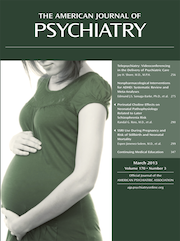Primary prevention has seemed an impossible dream for mental illness. Yet here is a study that comes up with interesting and provocative findings. The article by Ross et al. in this issue (
1) is a rare and important scientific study of how a dietary supplement in pregnancy may alter infant behavior. The behavior that is altered is the infant brain’s diminished reaction to a repeated sound. The measure was chosen because in adults, failure of this inhibitory brain system (prepulse inhibition) is seen in a high proportion of patients with schizophrenia and is also linked with the CHRNA7 genotype, which is associated with risk for schizophrenia (
2).
While the neurodevelopmental model of schizophrenia is the dominant model for schizophrenia today, the “model” simply posits that there are abnormalities in neurodevelopment that occur long before the onset of psychosis. The model allows for various genetic and environmental risk factors and various vulnerable time points in development (
3). The study by Ross and colleagues reflects a novel approach: potential prevention through a specific prenatal dietary treatment. The outcome measure is, of course, not schizophrenia per se, which would occur many years later, but a surrogate marker of brain function that can be measured in infancy.
This study represents the latest step in a programmatic study of the biology and genetics of schizophrenia that formulated a specific neurodevelopmental model and proposes a potential preventive prenatal dietary treatment. The senior author, Robert Freedman, and co-workers have shown that α7-nicotinic receptors, which are decreased in the brains of patients with schizophrenia, are related to defects of brain habituation, which characterizes many patients with the disorder. This group has also shown that this ability of the brain to “adapt” to a repeated sound develops in infancy. Several risk factors for schizophrenia are associated with the failure of this system to fully develop in infancy.
Since choline is critical for the development of α7-nicotinic receptors, the authors carried out a double-blind, placebo-controlled trial of choline supplementation given to 100 medically healthy pregnant women, starting in the second trimester and continuing until delivery. The major finding was that at 33 days of age, 76% of the infants who received choline had intact cerebral inhibition while only 43% of the placebo-treated group did so, a highly significant difference. The authors also present preliminary evidence from a separate group of infants studied 4 years earlier that deficient inhibition in infancy is associated with symptoms of inattention at age 4. This opens up the question of whether larger preventive studies for schizophrenia should be undertaken.
Prevention through maternal diet during pregnancy has been successful on rare previous occasions, most notably for neural tube defects, which are best prevented by supplementing the maternal diet with folic acid, which remains the best treatment for the disorder (
4). While Ross et al. acknowledge that their choline study is not powered or planned to address prevention of schizophrenia, it represents a landmark proof of concept showing that such an approach might be possible.
The delayed development in inhibition was transient in this study, as no difference was seen at a second measure at 89 days. It is well known that many if not most of the early developmental abnormalities seen in subjects at high risk for schizophrenia are themselves gone before the onset of psychosis. Recent work has shown that childhood abnormalities in anatomic brain development may normalize in some siblings of patients with schizophrenia (
5,
6). Other, as yet unknown brain abnormality clearly remains in these siblings, as the future risk for schizophrenia does not change.
Ongoing studies in these same subjects are examining functional imaging, which may be more sensitive to risk.
Where do we go from here? Improving infant brain inhibition is not prevention of schizophrenia. A surrogate marker is probably the only option for studying prevention of a disorder that will not occur for decades. The folic acid/neural tube defect studies had the research advantage of a disorder manifest early in life. Is it possible to carry out a large preventive study where the clinical outcome will not be known for so long? One hope is that neurodevelopmental improvement would be nonspecific and that choline treatment could improve multiple behaviors, such as attention (already suggested by the authors’ data on 4-year-olds with poor inhibition in infancy), impulsivity, or mood instability, all of which could be measured long before the age of risk for psychosis. Even if such a treatment were effective, the many known risk factors for schizophrenia would mean that addressing any one of them might not make a significant difference in long-term outcome. For example, in a recent study genetic risk factors even in multiplex families accounted for only 0.4% of the risk for illness (
7). At the other extreme, prevention of 44% of the cases of schizophrenia has been postulated through neonatal vitamin D supplementation for a particular Danish cohort of cases (
8). It is probable that risk varies widely with time period and populations (
9). Prenatal exposures to infection and malnutrition are the best bets for public health intervention, but a clear way forward is not yet compelling.

